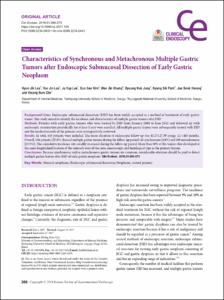KUMEL Repository
1. Journal Papers (연구논문)
1. School of Medicine (의과대학)
Dept. of Internal Medicine (내과학)
Characteristics of synchronous and metachronous multiple gastric tumors after endoscopic submucosal dissection of early gastric neoplasm
- Keimyung Author(s)
- Hwang, Jae Seok; Cho, Kwang Bum; Park, Kyung Sik; Lee, Ju Yup; Lee, Yoo Jin; Chung, Woo Jin; Jang, Byoung Kuk
- Department
- Dept. of Internal Medicine (내과학)
- Journal Title
- Clinical Endoscopy
- Issued Date
- 2018
- Volume
- 51
- Issue
- 3
- Abstract
- Background/Aims:
Endoscopic submucosal dissection (ESD) has been widely accepted as a method of treatment of early gastric tumor. This study aimed to identify the incidence and characteristics of multiple gastric tumors after ESD.
METHODS:
Patients with early gastric tumors who were treated by ESD from January 2004 to June 2012 and followed up with endoscopic examination periodically for at least 1 year were enrolled. All multiple gastric lesions were subsequently treated with ESD and the medical records of the patients were retrospectively reviewed.
RESULTS:
In total, 643 patients were included. The mean duration of endoscopic follow-up was 45.27±27.59 (range, 12-148) months. Overall, 144 patients (22.4%) showed multiple gastric tumors during the follow-up period (44 synchronous [6.8%] and 100 metachronous [15.5%]). The cumulative incidence rate steadily increased during the follow-up period. More than 50% of the tumors that developed at the same longitudinal location of the stomach were of the same macroscopic and histological type as the primary lesions.
Conclusions:
Because synchronous and/or metachronous gastric tumors are common, considerable attention should be paid to detect multiple gastric lesions after ESD of early gastric neoplasm.
- Publisher
- School of Medicine (의과대학)
- Citation
- Hyun Jik Lee et al. (2018). Characteristics of synchronous and metachronous multiple gastric tumors after endoscopic submucosal dissection of early gastric neoplasm. Clinical Endoscopy, 51(3), 266–273. doi: 10.5946/ce.2017.109
- Type
- Article
- ISSN
- 2234-2400
- Appears in Collections:
- 1. School of Medicine (의과대학) > Dept. of Internal Medicine (내과학)
- 파일 목록
-
-
Download
 oak-2018-0210.pdf
기타 데이터 / 814.4 kB / Adobe PDF
oak-2018-0210.pdf
기타 데이터 / 814.4 kB / Adobe PDF
-
Items in Repository are protected by copyright, with all rights reserved, unless otherwise indicated.